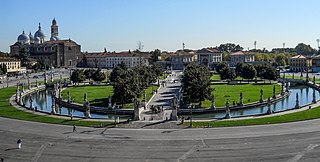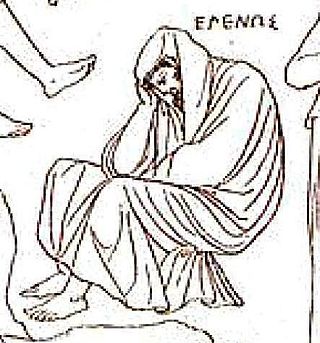
In Greco-Roman mythology, Aeneas was a Trojan hero, the son of the Trojan prince Anchises and the Greek goddess Aphrodite. His father was a first cousin of King Priam of Troy, making Aeneas a second cousin to Priam's children. He is a minor character in Greek mythology and is mentioned in Homer's Iliad. Aeneas receives full treatment in Roman mythology, most extensively in Virgil's Aeneid, where he is cast as an ancestor of Romulus and Remus. He became the first true hero of Rome. Snorri Sturluson identifies him with the Norse god Víðarr of the Æsir.

Padua is a city and comune in Veneto, northern Italy, and the capital of the eponymous province of Padua. The city lies on the banks of the river Bacchiglione, 40 kilometres west of Venice and 29 km southeast of Vicenza, and has a population of 214,000. It is also the economic and communications hub of the area. Padua is sometimes included, with Venice and Treviso, in the Padua-Treviso-Venice Metropolitan Area (PATREVE) which has a population of around 2,600,000.

In Greek mythology, Helenus was a gentle and clever seer. He was also a Trojan prince as the son of King Priam and Queen Hecuba of Troy, and the twin brother of the prophetess Cassandra. He was also called Scamandrios, and was a lover of Apollo.
Alcathous was the name of several people in Greek mythology:

A sarcophagus is a coffin, most commonly carved in stone, and usually displayed above ground, though it may also be buried. The word sarcophagus comes from the Greek σάρξsarx meaning "flesh", and φαγεῖνphagein meaning "to eat"; hence sarcophagus means "flesh-eating", from the phrase lithos sarkophagos, "flesh-eating stone". The word also came to refer to a particular kind of limestone that was thought to rapidly facilitate the decomposition of the flesh of corpses contained within it due to the chemical properties of the limestone itself.

The Veneti were an Indo-European people who inhabited northeastern Italy, in an area corresponding to the modern-day region of Veneto, from the middle of the 2nd millennium BC and developing their own original civilization along the 1st millennium BC.

The ancient Egyptians had an elaborate set of funerary practices that they believed were necessary to ensure their immortality after death. These rituals included mummifying the body, casting magic spells, and burials with specific grave goods thought to be needed in the afterlife.

Tenea is a municipal unit within the municipality of Corinth, Corinthia, Peloponnese, Greece. The municipal unit has an area of 167.575 km2 (64.701 sq mi). Until 2011, it was a municipality whose seat was in Chiliomodi.
In Greek mythology, Antenor was a counselor to King Priam of Troy during the events of the Trojan War.

The sarcophagus of Lucius Cornelius Scipio Barbatus, consul in 298 B.C., is a solid tuff burial coffin, once located in the Tomb of the Scipios. It is now found in the Vestibolo Quadrato of the Pio-Clementine Museum in the Vatican Museum complex.

Funerary art is any work of art forming, or placed in, a repository for the remains of the dead. The term encompasses a wide variety of forms, including cenotaphs, tomb-like monuments which do not contain human remains, and communal memorials to the dead, such as war memorials, which may or may not contain remains, and a range of prehistoric megalithic constructs. Funerary art may serve many cultural functions. It can play a role in burial rites, serve as an article for use by the dead in the afterlife, and celebrate the life and accomplishments of the dead, whether as part of kinship-centred practices of ancestor veneration or as a publicly directed dynastic display. It can also function as a reminder of the mortality of humankind, as an expression of cultural values and roles, and help to propitiate the spirits of the dead, maintaining their benevolence and preventing their unwelcome intrusion into the lives of the living.

The Tomb of the Scipios, also called the hypogaeum Scipionum, was the common tomb of the patrician Scipio family during the Roman Republic for interments between the early 3rd century BC and the early 1st century AD. Then it was abandoned and within a few hundred years its location was lost.
In Greek mythology, Demoleon was a Trojan warrior, son of Antenor and Theano. His father was a counselor to King Priam and his mother was a priestess of Athena.
In Greek mythology, Polybus or Polybius was the son of Antenor and Theano. He was the brother of Crino, Acamas, Agenor, Antheus, Archelochus, Coön, Demoleon, Eurymachus, Glaucus, Helicaon, Iphidamas, Laodamas, Laodocus, Medon and Thersilochus.
In Greek mythology, Panthous, son of Othrys, was an elder of Troy, husband of the "queenly" Phrontis and father of Euphorbus, Polydamas and Hyperenor. Because he was the son of Othrys, he had the patronymic Othryades.
Lovato Lovati (1241–1309) was an Italian scholar, poet, notary, judge and humanist from the High Middle Ages and early Italian Renaissance. Arguable among historians, Lovati is considered the "father of Humanism." His literary Padua circle included Rolando de Piazzola, Geremia da Montagnone, and Albertino Mussato. Lovati's scholarship marked characteristics which would later define the development of humanism: an appetite for classical texts; a philological concern to correct them, and ascertain their meaning; and a desire to imitate them. Scholars such as Petrarch commented on his works favorably. Lovati's achievements which survive today are his Latin verse epistles, and his short commentary of Seneca's tragedies.

The Tomb of Dante is an Italian neoclassical national monument built over the tomb of the poet Dante Alighieri in 1781. It is sited next to the Basilica of San Francesco in central Ravenna.

The Altıkulaç Sarcophagus, or Çan sarcophagus, is an early 4th century BCE sarcophagus. It is sometimes said to be in the Greco-Persian style. The sarcophagus was found in 1998 in a circular corbel-vaulted tomb within the Çingenetepe tumulus, in the village of Altıkulaç, near Çan, in the eastern Troad, about halfway between Troy and Daskyleion, in what was anciently Hellespontine Phrygia. It was looted and damaged in the process, but a large part of the reliefs remained intact. It is made of painted marble carved in low relief, and dated to the 1st quarter 4th century BCE. It was made at about the same time as the famous tombs in Lycia.
In Greek mythology, Theano was the priestess of Athena in Troy.

Hama was a queen of the Neo-Assyrian Empire as the primary consort of Shalmaneser IV. Historical records reveal next to nothing about Hama, and the vast majority of the information known about the queen comes from studies on her skeletal remains and the contents of the bronze coffin she was buried in, discovered by modern researchers in 1988 but not securely identified as Hama until 2017. Hama's skeleton indicates that she died at a young age, at some point between the age of 18 and 20, and that she suffered from some mild health issues, including gingivitis, dental plaque and chronic sinusitis.













